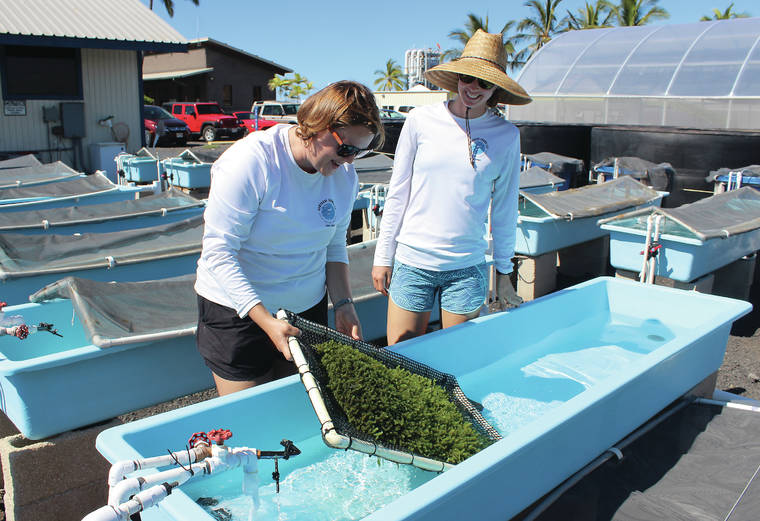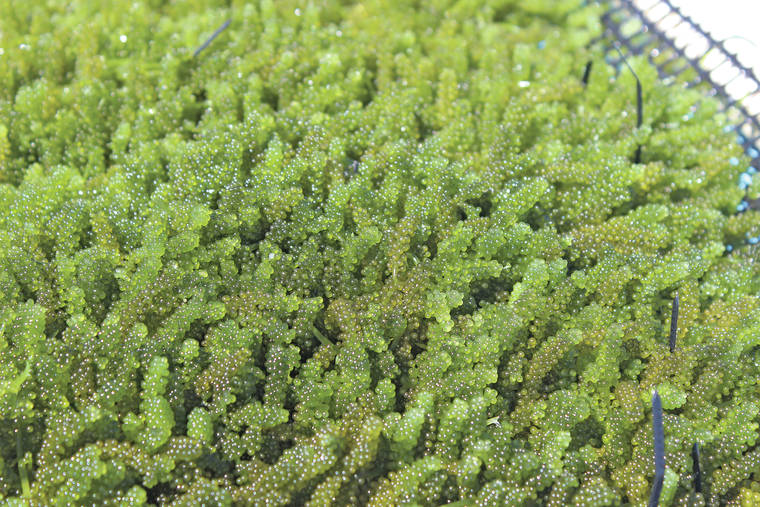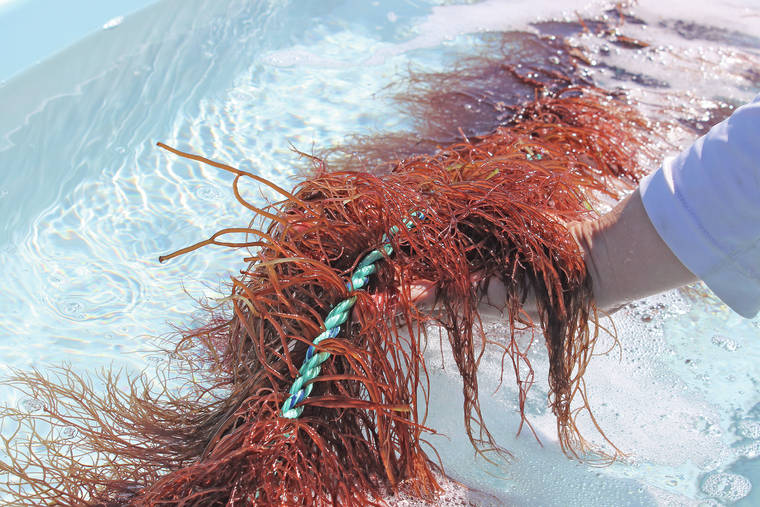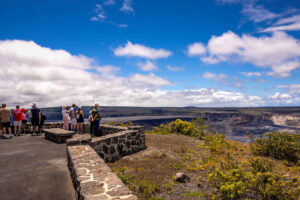KAILUA-KONA — Kampachi Farms plans to begin testing next summer an underwater farm the mariculture company hopes will produce large quantities of limu — edible seaweed — off the Kona Coast.
During the three-year Blue Fields Offshore Native Hawaiian Macroalgae Demonstration Project, Kampachi Farms will study technologies and tools for growing offshore four native or endemic Hawaiian limu species on an array suspended about 30 feet below the ocean surface using only natural energy.
While in Hawaii, limu is mostly known as an ingredient in poke, a traditional Hawaiian dish of diced raw fish, stews and salads or as a condiment adding crunch and zest, there’s other valuable and marketable uses as well, including feed for fish and land animals and biofuel of interest to the U.S. Department of Energy.
“Our initial target is food and feed and then long-term, for the next 10 or 15 years, show we can grow this for fuels,” said Neil Sims, Kampachi Farms CEO.
If successful, Sims said the company, which he founded in 2011 with Michael Bullock to continue research and advance commercial kampachi production, would look at scaling the operation.
“The goal — if it works — is to move toward commercialization,” said Sims.
A final environmental assessment with a finding the project will have no significant impact was published last week by the state allowing the project to move forward.
A number of requirements must still be met before deployment, including securing a state conservation district use permit and a permit from the U.S. Arch Corps of Engineers because the project is proposed in U.S. waters.
If all goes as planned, and all permits, certifications and consultations are obtained, Lisa Vollbrecht, the project’s research manager, is anticipating getting the array in the water next summer.
What it
will look like
As proposed, the apparatus would be single-point moored in waters about 400 feet deep south-southeast of Kaiwi Point, about 1.5 miles out from Kailua Pier and adjacent to Pawai Bay. Only marker buoys and a wave-driven upwelling pump would be visible from shore.
Approximately 33 feet below, a submersible growth platform measuring about 33 feet by 131 feet and able to rotate 360 degrees will be suspended. On the platform, 98-foot “algal lines” will be strung for the macroalgae to affix and grow. Nutrient-rich deep sea water will be brought to the array via the wave-driven pump pushing water from a depth of about 985 feet through a 2,300-foot pipe.
The company stated it will not be seeking “exclusive use” of the area, meaning that fishing vessels and the public will be permitted to traverse the entire project area within safe operating distance from its infrastructure.
“The local community is going to find this is a great fish aggregating device (FAD) — it’s going to attract and hold fish,” said Sims.
Sims declined to provide a cost estimate for the project, saying it is proprietary in nature. A $499,000 Advanced Research Projects Agency — Energy grant from the Department of Energy is helping to offset costs.
The demonstration has the potential to expand the areas where offshore algae cultivation is commercially feasible in the U.S. by addressing the challenges presented by cost and lack of nutrients in surface water, according to an ARPA-E project listing for the demonstration. The creation and validation of such technologies and tools are needed to “allow the United States to become a world leader in marine biomass production for multiple important applications” including food for human consumption, feed for animals and biofuel.
The agency, according to the project listing, estimates the U.S. has suitable conditions and geography to produce at least 500 million dry metric tons of macroalgae per year. That could yield about 2.7 quadrillion BTUs (quads) of energy in the form of liquid fuel, roughly 10% of the nation’s annual transportation energy demand.
“This demonstration is fundamental frontier research. The potential for commercial scale development of such systems is still several decades in the future. However, validation of this offshore macroalgae culture system will reinforce Kona as being a leading center for offshore aquaculture development,” the final EA reads.
Added benefits
In addition, macroalgae can have a positive impact on the environment as it absorbs carbon dioxide, countering ocean acidification, if grown at a large enough scale.
“We’ve been thinking about this for some time as an important way to counter global climate change,” Sims said.
Kampachi Farms has already invested about a year into the project, testing on land at its Natural Energy Laboratory Authority of Hawaii facility a handful of limu — called macroalgae — for survivability in offshore tropical waters using the deep sea water supplied there.
“They’re nutrient deserts. There are hardly any nutrients out there,” said Vollbrecht about the offshore environment. “That’s one of the biggest challenges in tropical oceans.”
Through the research, which also included assessing what depth the platform had to be at and what type of seeding/germination would be required, the team narrowed down the list of seven or eight candidates for trial.
According to Keelee Martin, the team’s macroalgae technician, there are 522 species of macroalgae found in Hawaiian waters.
“We’ve tested them in the conditions that we think we can supply on the array just to see if they can survive and grow well and we’ve got them down to a select few that we are going to go forward with,” said Vollbrecht.
The species that will be grown during the demonstration are ogo or limu manauea (Gracilaria parvispora), limu kala (Sargassum aquifolium), limu kohu (Asparagopsis taxiformis) and Caulerpa lentillifera, she said. The latter doesn’t have a known Hawaiian name but is called limu fuafua in Samoa. It’s also termed sea grapes or vegan caviar as the macroalgae provides the same salty “pop” tobiko (flying fish roe) gives poke.
The limu kohu, limu kala and Caulerpa lentillifera were collected from sites around the Big Island while the ogo was provided by an Oahu research facility because it is does not readily grow on the reef as it prefers sandy, eroded limestone.
One species the team is excited to use in the demonstration project is the coveted limu kohu. A very seasonal species, the red macroalgae is typically only available in stores for a short period in the spring and can command a high price of $25-$27 per pound, said Martin.
It’s also sought by the Australians who have found its use as a feed product for cattle reduces methane emissions. Its bromide content is also of interest to the pharmaceutical industry.
“There’s people all over the world trying to figure out how to culture Asparagopsis,” she said. “We attempted and tested it (for its applicability in the demonstration project) but it didn’t last very long.”
But, they’re going to keep trying with the limu kohu, continuing with land-based experimentation for some time until — hopefully — it can join its counterparts in the offshore waters.
Once going, the team currently believes harvest will occur annually, however, there are so many variables that could affect that timeline such as growth rate and nutrient dispersal. In the draft EA for the project, Kampachi Farms estimated it would harvest 12.5 tons of macroalgae during the project.
“Turning a harvest is the reason why it’s being tested,” said Vollbrecht.
According to the environmental assessment, any limu harvested during the demonstration will go to organizations like The Food Basket or the culinary arts program at Hawaii Community College — Palamanui.











